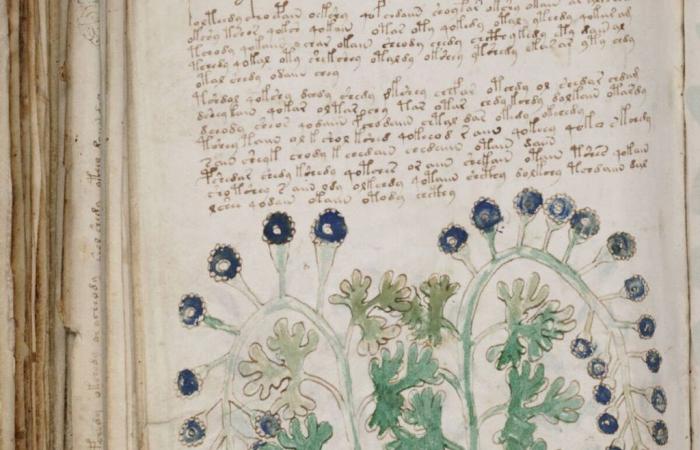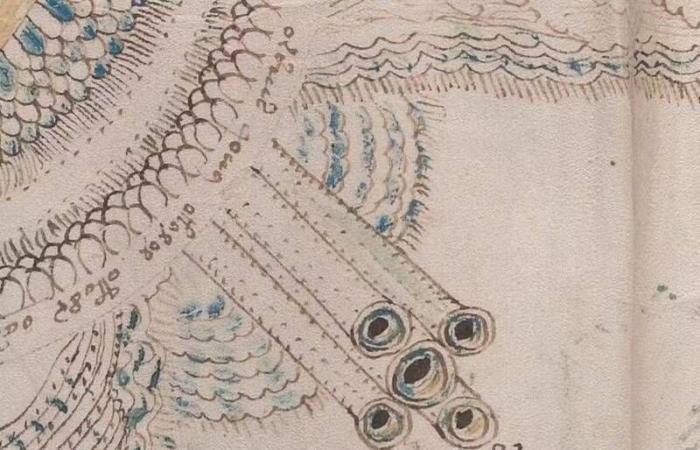One of the pages of the Voynich Manuscript.
After decades of trying to decode the Voynich manuscript, researchers say in a new study, based on similar medieval texts, that at least part of the text may be about “female secrets.”
The mysterious Voynich manuscript, a centuries-old text written in an unknown language and with strange, otherworldly illustrations, has long fascinated historians.
Since its rediscovery in 1912, countless scholars have tried—and largely failed—to decipher the meaning and origins of this strange book.
The text from the late Middle Ages is full of illustrations which represent a wide variety of objects, from stars and planets to plants and naked women.
This strange mix of images, combined with an indecipherable text, only further confused the mystery of the book’s meaning. But now, a pair of researchers believes he has unraveled part of the meaning of the manuscript: sex may be one of the themes covered in the mysterious text.
In a study recently published in the scientific journal Social History of Medicine, Keagan Brewer It is Michelle L. Lewisresearchers at Macquarie University, examined the most prominent illustration in the Voynich manuscript, the so-called Rosettesand compared it with other texts from the medieval period.
Rosettes are the “largest and most elaborate illustration” from the Voynich manuscript, an extensive folding of several pages with nine circles linked together, astronomical symbols, tubes, lamps, passages, castles and city walls.
At first glance, it looks like a map of a city, but not a city that ever existed on Earth. However, based on patriarchal patterns observed in other late medieval works, the Rosettes may suggest a deeper meaning.
Yale UniversityLibrary
The “five veins” of the Rosettes of the Voynich Manuscript
“In late medieval times, it was believed that the uterus had seven chambers and the vagina has two openings, one external and one internal”, explains Keagan Brewer in an article on The Conversation.
“We believe that the nine large circles of the Rosettes represent these openings, with the central circle representing the external opening and the upper left circle representing the internal opening”, details the researcher.
There is other subtle clues throughout the illustration which may also be related to the understanding of sex in the late Middle Ages.
Near the top left circle, for example, hthere are five small tubes that run towards the center of the illustration. Based on the writings of the influential Persian physician Abu Bakr Al-Rāzī, These could represent the five small veins that, at the time, were believed to be present in the vaginas of virgins.
Even at first glance, it is clear that the Voynich manuscript addresses a number of varied topics including botany, astrology, astronomy and anatomy, just based on the various illustrations in the document. However, the meaning of these images has often been contradictory.
“A section contains illustrations of naked women holding objects adjacent to or facing your genitals,” explains Brewer.
“These images could not be from an exclusively herbal manuscript or astronomical. To make sense of these images, we investigated the culture of gynecology and sexology in the late Middle Ages – which doctors of the time often referred to as women’s secrets“, says Brewer.
Firstly, Brewer and Lewis pored over the writings of the Bavarian doctor Johannes Hartliebwho lived between 1410 and 1468 – around the time and place where the Voynich manuscript was created.
Hartlieb wrote frequently on many of the topics covered in the Voynich manuscript, including plants, astronomy, women and magic.
However, Hartlieb was a man of his time, quite conservative in his views on women’s sexuality and afraid that God would punish him for writing about “women’s secrets” so blatantly.
Thus, Hartlieb often used “secret letters” as ciphers or secret alphabets for conceal medical information that could lead to contraceptionabortion or sterility.
Unfortunately, Hartlieb’s secret alphabet was lostIt is. But, according to Brewer, “the analysis of his work helped us understand the attitudes that inspired the use of the cipher at the time”.
According to Brewer, Hartlieb was very concerned that if “women’s secrets” become widely knownthis could result in a increase in extramarital sex and that God would punish it for sharing this forbidden knowledge.
In his various other writings, Hartlieb “refuses or hesitates” to write about topics such as postpartum vaginal ointmentswomen’s sexual pleasure and contraceptive or abortive plants.
Hartlieb firmly believed that this knowledge it was only for men nobles and that it should be kept away from women, sex workers, common people and children.
The Bavarian doctor was not the only academic to carry out this self-censorship, which sometimes consisted simply of hiding a genital term or the name of a plant in a recipe.
In the case of a Bavarian text that contained recipes for invisibility and magical spells designed to sexually coerce women, censorship involved the removing entire pages from the manuscript.
Perhaps, the study authors suggest, a similar form of censorship has been applied to the Voynic manuscript. — which offers at least one important explanation for the text of the document.
Thus, part of the mystery of the indecipherable book written in a language that does not exist with never-before-seen creatures may have been solved.

Tags: Mysterious Voynich Manuscript Sex Advice Womens Secrets
--







